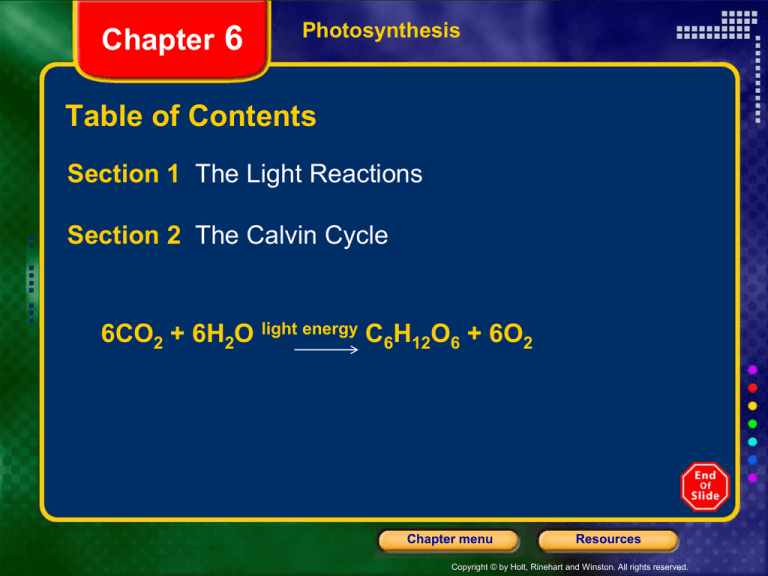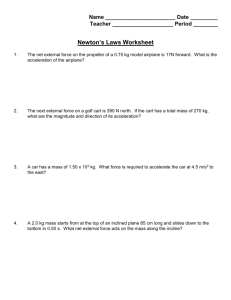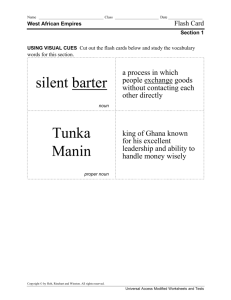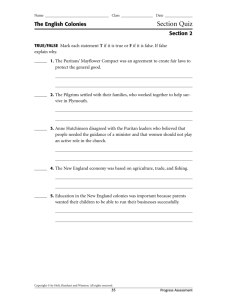
Chapter 6
Photosynthesis
Table of Contents
Section 1 The Light Reactions
Section 2 The Calvin Cycle
6CO2 + 6H2O light energy C6H12O6 + 6O2
Chapter menu
Resources
Copyright © by Holt, Rinehart and Winston. All rights reserved.
Chapter 6
Section 1 The Light Reactions
Objectives
• Explain why almost all organisms depend on
photosynthesis.
• Describe the role of chlorophylls and other pigments
in photosynthesis.
• Summarize the main events of the light reactions.
• Explain how ATP is made during the light reactions.
Chapter menu
Resources
Copyright © by Holt, Rinehart and Winston. All rights reserved.
Chapter 6
Section 1 The Light Reactions
Obtaining Energy
• Photosynthesis
converts light energy
from the sun into
chemical energy in the
form of organic
compounds through a
series of reactions
known as biochemical
pathways.
Chapter menu
Resources
Copyright © by Holt, Rinehart and Winston. All rights reserved.
Chapter 6
Section 1 The Light Reactions
• Autotrophs use energy
from sunlight or from
chemical bonds in inorganic
substances to make organic
compounds.
• Animals and other
organisms that must get
energy from food instead of
directly from sunlight or
inorganic substances are
called heterotrophs.
Chapter menu
Resources
Copyright © by Holt, Rinehart and Winston. All rights reserved.
Chapter 6
Section 1 The Light Reactions
Overview of Photosynthesis
• The oxygen (O2) and
some of the organic
compounds produced
by photosynthesis are
used by cells in a
process called cellular
respiration.
• Plants carry out cellular
respiration as well as
photosynthesis!!
Chapter menu
Resources
Copyright © by Holt, Rinehart and Winston. All rights reserved.
Chapter 6
Section 1 The Light Reactions
• Photosynthesis can be divided
into two stages: Light
Reactions and Calvin Cycle
– In the light reactions, light
energy is converted to
chemical energy, which is
temporarily stored in ATP
and the energy carrier
molecule NADPH.
– In the Calvin Cycle, organic
compounds are formed using
CO2 and the chemical energy
stored in ATP and NADPH.
Chapter menu
Resources
Copyright © by Holt, Rinehart and Winston. All rights reserved.
Chapter 6
Section 1 The Light Reactions
Overview of Photosynthesis, continued
• Equation of Photosynthesis:
6CO2 + 6H2O light energy C6H12O6 + 6O2
Chapter menu
Resources
Copyright © by Holt, Rinehart and Winston. All rights reserved.
Chapter 6
Section 1 The Light Reactions
Capturing Light Energy
• The light
reactions
begin with the
absorption of
light in
chloroplasts,
organelles
found in the
cells of plants,
some bacteria,
and algae.
Chapter menu
Resources
Copyright © by Holt, Rinehart and Winston. All rights reserved.
Chapter 6
Section 1 The Light Reactions
• Light and Pigments
– White light from the sun is composed of an array of
colors called the visible spectrum.
– Pigments absorb certain colors of light and reflect
or transmit the other colors.
Chapter menu
Resources
Copyright © by Holt, Rinehart and Winston. All rights reserved.
Chapter 6
Section 1 The Light Reactions
Capturing Light Energy, continued
• Chloroplast Pigments
– Located in the membrane of the thylakoids of
chloroplasts are several pigments, including
chlorophylls (such as chlorophyll a and chlorophyll
b) and carotenoids.
Chapter menu
Resources
Copyright © by Holt, Rinehart and Winston. All rights reserved.
Chapter 6
Section 1 The Light Reactions
Converting Light Energy To Chemical Energy
• The pigments are grouped in clusters of a few
hundred molecules in the thylakoid membrane. Each
cluster and the proteins that the pigment molecules
are embedded in are referred to collectively as a
photosystem.
• By absorbing light, pigment molecules in
photosystem I and photosystem II acquire some of
the energy carried by the light.
Chapter menu
Resources
Copyright © by Holt, Rinehart and Winston. All rights reserved.
Chapter 6
Section 1 The Light Reactions
Converting Light Energy To Chemical Energy,
continued
• In each photosystem, the acquired energy is passed
quickly to other pigment molecules until it reaches a
specific pair of chlorophyll a molecules.
• The acquired energy forces electrons to enter a
higher energy level in the two chlorophyll a molecules
of photosystem II. These energized electrons are said
to be “excited.” The excited electrons have enough
energy to leave the chlorophyll a molecules.
Chapter menu
Resources
Copyright © by Holt, Rinehart and Winston. All rights reserved.
Chapter 6
Section 1 The Light Reactions
Converting Light Energy To Chemical Energy,
continued
• The acceptor of these electrons from photosystem II
is a molecule called the primary electron acceptor,
which donates the electrons to the electron transport
chain.
• As the electrons move from molecule to molecule in
this chain, they lose most of the acquired energy. The
energy they lose is used to move protons into the
thylakoid.
Chapter menu
Resources
Copyright © by Holt, Rinehart and Winston. All rights reserved.
Chapter 6
Section 1 The Light Reactions
Chapter menu
Resources
Copyright © by Holt, Rinehart and Winston. All rights reserved.
Chapter 6
Section 1 The Light Reactions
Converting Light Energy To Chemical Energy,
continued
• Light is absorbed by photosystem I at the same time it
is absorbed by photosystem II. Electrons move from
chlorophyll a molecules to another primary electron
acceptor.
• The electrons lost from photosystem I are replaced by
electrons that have passed through the electron
transport chain from photosystem II.
Chapter menu
Resources
Copyright © by Holt, Rinehart and Winston. All rights reserved.
Chapter 6
Section 1 The Light Reactions
Converting Light Energy To Chemical Energy,
continued
• These electrons are then donated to another electron
transport chain, which brings the electrons to the side
of the thylakoid membrane that faces the stroma.
• In the stroma, the electrons combine with a proton
and NADP+. This causes NADP+ to be reduced to
NADPH.
Chapter menu
Resources
Copyright © by Holt, Rinehart and Winston. All rights reserved.
Chapter 6
Section 1 The Light Reactions
Converting Light Energy To Chemical Energy,
continued
•
Replacing Electrons in Light
Reactions
– Electrons from photosystem II
replace electrons that leave
photosystem I. Replacement
electrons for photosystem II
are provided by the splitting of
water molecules.
– Oxygen produced when
water molecules are split
diffuses out of the chloroplast
and then leaves the plant.
Chapter menu
Resources
Copyright © by Holt, Rinehart and Winston. All rights reserved.
Chapter 6
Section 1 The Light Reactions
Converting Light Energy To Chemical Energy,
continued
• Making ATP in Light
Reactions
– An important part of the
light reactions is the
synthesis of ATP. During
chemiosmosis, the
movement of protons
through ATP synthase into
the stroma releases
energy, which is used to
produce ATP.
Chapter menu
Resources
Copyright © by Holt, Rinehart and Winston. All rights reserved.
Chapter 6
Section 1 The Light Reactions
Chapter menu
Resources
Copyright © by Holt, Rinehart and Winston. All rights reserved.
Chapter 6
Section 2 The Calvin Cycle
Objectives
• Summarize the main events of the Calvin cycle.
• Describe what happens to the compounds that are
made in the Calvin cycle.
• Distinguish between C3, C4, and CAM plants.
• Summarize how the light reactions and the Calvin
cycle work together to create the continuous cycle of
photosynthesis.
• Explain how environmental factors influence
photosynthesis.
Chapter menu
Resources
Copyright © by Holt, Rinehart and Winston. All rights reserved.
Chapter 6
Section 2 The Calvin Cycle
Carbon Fixation
• The ATP and NADPH produced in the light reactions
drive the second stage of photosynthesis, the Calvin
cycle.
• In the Calvin cycle, CO2 is incorporated into organic
compounds, a process called carbon fixation.
Chapter menu
Resources
Copyright © by Holt, Rinehart and Winston. All rights reserved.
Chapter 6
Section 2 The Calvin Cycle
Carbon Fixation, continued
• The Calvin cycle, which occurs in the stroma of the
chloroplast, is a series of enzyme-assisted chemical
reactions that produces a three-carbon sugar.
• Most of the three-carbon sugars (G3P) generated in
the Calvin cycle are converted to a five-carbon sugar
(RuBP) to keep the Calvin cycle operating. But some
of the three-carbon sugars leave the Calvin cycle and
are used to make organic compounds, in which energy
is stored for later use.
Chapter menu
Resources
Copyright © by Holt, Rinehart and Winston. All rights reserved.
Chapter 6
Section 2 The Calvin Cycle
Chapter menu
Resources
Copyright © by Holt, Rinehart and Winston. All rights reserved.
Chapter 6
Section 2 The Calvin Cycle
Alternative Pathways
• The C4 Pathway
– Some plants that evolved in hot, dry climates fix
carbon through the C4 pathway. These plants have
their stomata partially closed during the hottest part
of the day.
– Certain cells in these plants have an enzyme that
can fix CO2 into four-carbon compounds even when
the CO2 level is low and the O2 level is high. These
compounds are then transported to other cells,
where the Calvin cycle ensues.
Chapter menu
Resources
Copyright © by Holt, Rinehart and Winston. All rights reserved.
Chapter 6
Section 2 The Calvin Cycle
Alternative Pathways, continued
• The CAM Pathway
– Some other plants that evolved in hot, dry climates
fix carbon through the CAM pathway. These plants
carry out carbon fixation at night and the Calvin
cycle during the day to minimize water loss.
Chapter menu
Resources
Copyright © by Holt, Rinehart and Winston. All rights reserved.
Chapter 6
Section 2 The Calvin Cycle
Chapter menu
Resources
Copyright © by Holt, Rinehart and Winston. All rights reserved.
Chapter 6
Section 2 The Calvin Cycle
Factors That Affect Photosynthesis
• Light Intensity
– The rate of photosynthesis increases as light
intensity increases, because more electrons are
excited in both photosystems.
– However, at some point all of the available electrons
are excited, and the maximum rate of
photosynthesis is reached. The rate then stays level
regardless of further increases in light intensity.
Chapter menu
Resources
Copyright © by Holt, Rinehart and Winston. All rights reserved.
Chapter 6
Section 2 The Calvin Cycle
Factors That Affect Photosynthesis, continued
• Carbon Dioxide Levels
– As with increasing light intensity, increasing levels of
carbon dioxide also stimulate photosynthesis until
the rate levels off.
Chapter menu
Resources
Copyright © by Holt, Rinehart and Winston. All rights reserved.
Chapter 6
Section 2 The Calvin Cycle
Factors That Affect Photosynthesis, continued
• Temperature
– As temperature increases, the rate of
photosynthesis increases to a maximum and then
decreases with further rises in temperature.
– The rate peaks at a certain temperature, at which
many of the enzymes that catalyze the reactions
become ineffective. Also, the stomata begin to
close, limiting water loss and entry of carbon
dioxide.
Chapter menu
Resources
Copyright © by Holt, Rinehart and Winston. All rights reserved.
Chapter 6
Standardized Test Prep
Multiple Choice
1. Which of the following is a reactant in the Calvin
cycle?
A. O2
B. CO2
C. H2O
D. C6H12O6
Chapter menu
Resources
Copyright © by Holt, Rinehart and Winston. All rights reserved.
Chapter 6
Standardized Test Prep
Multiple Choice, continued
1. Which of the following is a reactant in the Calvin
cycle?
A. O2
B. CO2
C. H2O
D. C6H12O6
Chapter menu
Resources
Copyright © by Holt, Rinehart and Winston. All rights reserved.
Chapter 6
Standardized Test Prep
Multiple Choice, continued
2. Which of the following statements is correct?
F. Accessory pigments are not involved in
photosynthesis.
G. Accessory pigments add color to plants but do not
absorb light energy.
H. Accessory pigments absorb colors of light that
chlorophyll a cannot absorb.
J. Accessory pigments receive electrons from the
electron transport chain of photosystem I.
Chapter menu
Resources
Copyright © by Holt, Rinehart and Winston. All rights reserved.
Chapter 6
Standardized Test Prep
Multiple Choice, continued
2. Which of the following statements is correct?
F. Accessory pigments are not involved in
photosynthesis.
G. Accessory pigments add color to plants but do not
absorb light energy.
H. Accessory pigments absorb colors of light that
chlorophyll a cannot absorb.
J. Accessory pigments receive electrons from the
electron transport chain of photosystem I.
Chapter menu
Resources
Copyright © by Holt, Rinehart and Winston. All rights reserved.
Chapter 6
Standardized Test Prep
Multiple Choice, continued
3. Oxygen is produced at what point during
photosynthesis?
A. when CO2 is fixed
B. when water is split
C. when ATP is converted into ADP
D. when 3-PGA is converted into G3P
Chapter menu
Resources
Copyright © by Holt, Rinehart and Winston. All rights reserved.
Chapter 6
Standardized Test Prep
Multiple Choice, continued
3. Oxygen is produced at what point during
photosynthesis?
A. when CO2 is fixed
B. when water is split
C. when ATP is converted into ADP
D. when 3-PGA is converted into G3P
Chapter menu
Resources
Copyright © by Holt, Rinehart and Winston. All rights reserved.
Chapter 6
Standardized Test Prep
Multiple Choice, continued
The diagram below shows
a portion of a chloroplast.
Use the diagram to answer
the question that follows.
4. Which of the following
correctly identifies the
structure marked X and the
activities that take place
there?
F. stroma—Calvin cycle
G. stroma—light reactions
H. thylakoid—Calvin cycle
J. thylakoid—light reactions
Chapter menu
Resources
Copyright © by Holt, Rinehart and Winston. All rights reserved.
Chapter 6
Standardized Test Prep
Multiple Choice, continued
The diagram below shows
a portion of a chloroplast.
Use the diagram to answer
the question that follows.
4. Which of the following
correctly identifies the
structure marked X and the
activities that take place
there?
F. stroma—Calvin cycle
G. stroma—light reactions
H. thylakoid—Calvin cycle
J. thylakoid—light reactions
Chapter menu
Resources
Copyright © by Holt, Rinehart and Winston. All rights reserved.
Chapter 6
Standardized Test Prep
Multiple Choice, continued
5. light reactions : ATP :: Calvin cycle :
A. H+
B. O2
C. G3P
D. H2O
Chapter menu
Resources
Copyright © by Holt, Rinehart and Winston. All rights reserved.
Chapter 6
Standardized Test Prep
Multiple Choice, continued
5. light reactions : ATP :: Calvin cycle :
A. H+
B. O2
C. G3P
D. H2O
Chapter menu
Resources
Copyright © by Holt, Rinehart and Winston. All rights reserved.
Chapter 6
Standardized Test Prep
Multiple Choice, continued
The diagram below shows a
step in the process of
chemiosmosis. Use the
diagram to answer the question
that follows.
6. What is the substance
identified as Y in the
image?
F. H+
G. NAD+
H. NADPH
J. ADP synthase
Chapter menu
Resources
Copyright © by Holt, Rinehart and Winston. All rights reserved.
Chapter 6
Standardized Test Prep
Multiple Choice, continued
The diagram below shows a
step in the process of
chemiosmosis. Use the
diagram to answer the question
that follows.
6. What is the substance
identified as Y in the
image?
F. H+
G. NAD+
H. NADPH
J. ADP synthase
Chapter menu
Resources
Copyright © by Holt, Rinehart and Winston. All rights reserved.
Chapter 6
Standardized Test Prep
Short Response
Chloroplasts are organelles with areas that conduct
different specialized activities.
Where in the chloroplast do the light reactions and
the Calvin cycle occur?
Chapter menu
Resources
Copyright © by Holt, Rinehart and Winston. All rights reserved.
Chapter 6
Standardized Test Prep
Short Response, continued
Chloroplasts are organelles with areas that conduct
different specialized activities.
Where in the chloroplast do the light reactions and
the Calvin cycle occur?
Answer:
The light reactions of photosynthesis occur along the
thylakoid membrane. The Calvin cycle occurs in the
stroma, surrounding the thylakoids.
Chapter menu
Resources
Copyright © by Holt, Rinehart and Winston. All rights reserved.
Chapter 6
Standardized Test Prep
Extended Response
The reactions of photosynthesis make up a
biochemical pathway.
Part A What are the reactants and products for both
the light reactions and the Calvin cycle?
Part B Explain how the biochemical pathway of
photosynthesis recycles many of its own
reactants, and identify the recycled reactants.
Chapter menu
Resources
Copyright © by Holt, Rinehart and Winston. All rights reserved.
Chapter 6
Standardized Test Prep
Extended Response, continued
Answer:
Part A The reactants for the light reactions of
photosynthesis are sunlight, water, NADP+, and ADP.
The products are oxygen, ATP, and NADPH. The
reactants for the Calvin cycle are ATP, NADPH, CO2,
and RuBP. The products are NADP+, ADP, and
organic compounds.
Part B ADP/ATP, NADP+/NADPH, and electrons are
recycled during photosynthesis. RuBP, which reacts
with CO2 in the Calvin cycle, is regenerated at each
turn of the cycle.
Chapter menu
Resources
Copyright © by Holt, Rinehart and Winston. All rights reserved.









